Do Both Sets of Parents Sit Together at a Wedding? Navigating Seating Etiquette
In planning your wedding, one of the questions you might face is whether or not to seat both sets of parents together at the reception. This decision can be influenced by several factors, including family dynamics, the parents’ preferences, and the overall structure of your seating chart. Traditionally, parents are given a place of honor at the reception, which often means situating them close to the newlyweds. However, modern weddings are all about personalization and ensuring the comfort of all guests.
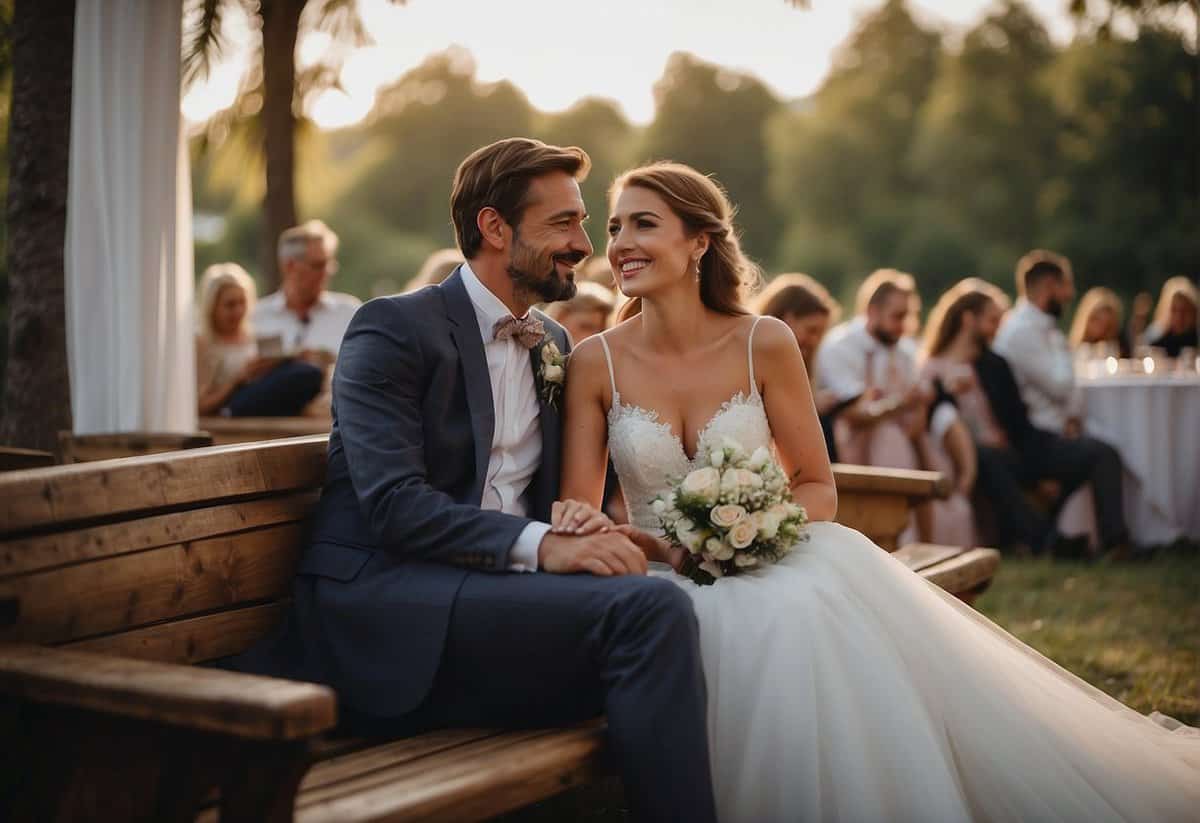
Understanding the nuances of wedding reception seating can help ensure a smooth and enjoyable celebration for everyone involved. It’s important to consider the relationships between the parents, as this might affect where they would be most comfortable sitting. While some parents might relish the chance to get to know each other better, others may prefer to celebrate within their own circle of friends and family. By prioritizing sightlines to the newlyweds and access to other guests of honor, you can design a seating chart that accommodates everyone’s needs while still respecting wedding etiquette.
Key Takeaways
- Seating arrangements factor in family dynamics and parental preferences.
- Placement reflects the importance and comfort of both sets of parents.
- The chart design balances tradition and personalization for an enjoyable experience.
Wedding Reception Seating Dynamics

When planning your wedding reception, understanding the seating dynamics is crucial to ensure that all guests, especially close family members, have a comfortable experience. This includes considering the relationships between guests when planning seating arrangements, accommodating divorced parents appropriately, and integrating siblings and extended family into the seating chart.
Understanding Family Relationships
The seating arrangement at your wedding can speak volumes about family relationships. Ideally, both sets of parents sit at the same table, usually one that’s close enough to offer a good view of the head table where you and your spouse will be seated. It’s essential to balance the seating to prevent any feelings of favoritism or exclusion. Here are the traditional roles:
- Both Sets of Parents: Sit at a prominent table together.
- Wedding Party: Close to the bride and groom but not necessarily at the same table.
- Guests: Arranged typically by relationship or affiliation with the couple.
Seating Arrangements for Divorced Parents
If your or your spouse’s parents are divorced, navigate this with care to avoid any awkwardness or discomfort. Here are a few arrangements:
- Directly Divorced: Each parent at their own table with equal prominence.
- Remarried Parents: New partners might join them or have separate tables depending on the dynamics.
For example:
- Mother and Stepfather: One table
- Father and Stepmother: Another table of equal prominence
Incorporating Siblings and Extended Family
Your siblings and extended family should be seated where they feel part of the celebration without imposing on the immediate family’s space. Consider the following:
- Immediate Family: Like siblings who are not in the wedding party, should be seated near the parents.
- Extended Family: Aunts, uncles, cousins can be at adjacent tables to maintain closeness.
Always remember, the goal is to make everyone feel included and important on your special day. Keep in mind the relationships between various family members to place them near people they’ll enjoy spending time with, and avoid seating guests with a history of conflict together.
Seating Chart Design and Etiquette
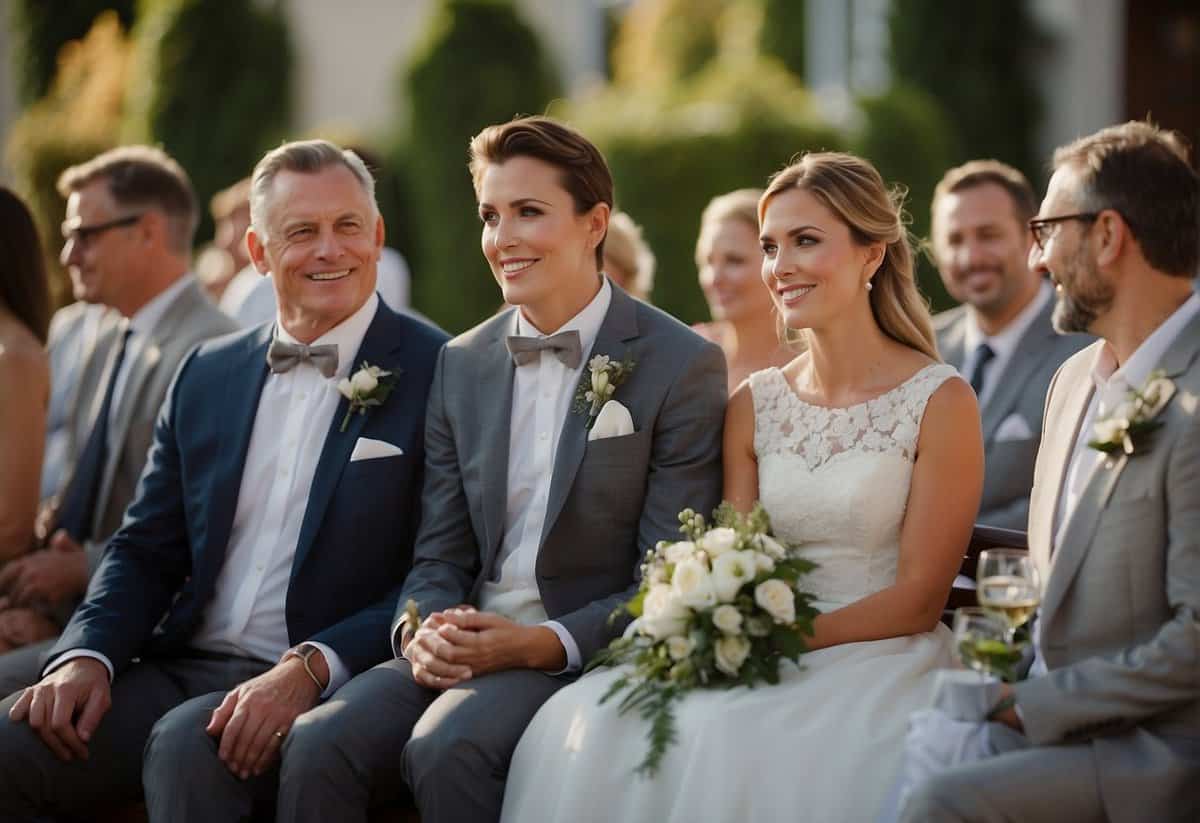
Crafting a seating chart for your wedding reception is akin to putting together a complex puzzle where the comfort and enjoyment of your guests are at stake. The placement of each person carries a significance that contributes to the flow and social dynamics of the event.
Arranging the Head Table
When arranging the head table, traditionally, the newlyweds are centered with the bride seated to the groom’s left. Typically, the maid of honor sits next to the groom, and the best man next to the bride, followed by the rest of the bridal party in alternating gender order. If you’re considering the parents joining the head table, etiquette suggests seating them at tables nearby. Some opt for a sweetheart table for just the couple, allowing family members to host their own tables with guests.
Assigning Guests to Tables
Creating a pleasant experience at assigned tables requires considering the relationships and backgrounds of your guests. Use place cards to guide guests to their designated seats, which helps to avoid confusion and creates a structured flow. When assigning guests, aim to group those with shared interests or familial connections, making each table an opportunity for enjoyable conversation and connection.
Placement of Wedding Officials and VIPs
Wedding officials, like your officiant, should be seated in a position of honor. They are often placed at a table with family or close friends of the couple. Meanwhile, seating for VIP guests, such as grandparents or special mentors, should be close to the head table to acknowledge their importance. Always take into account mobility issues or any special needs to ensure their comfort throughout the celebration.
When designing your seating chart, remember that clarity and thoughtfulness go a long way. The goal is to make everyone feel welcomed and included, allowing you to enjoy your special day knowing your guests are comfortably situated.
Special Considerations for Unique Situations
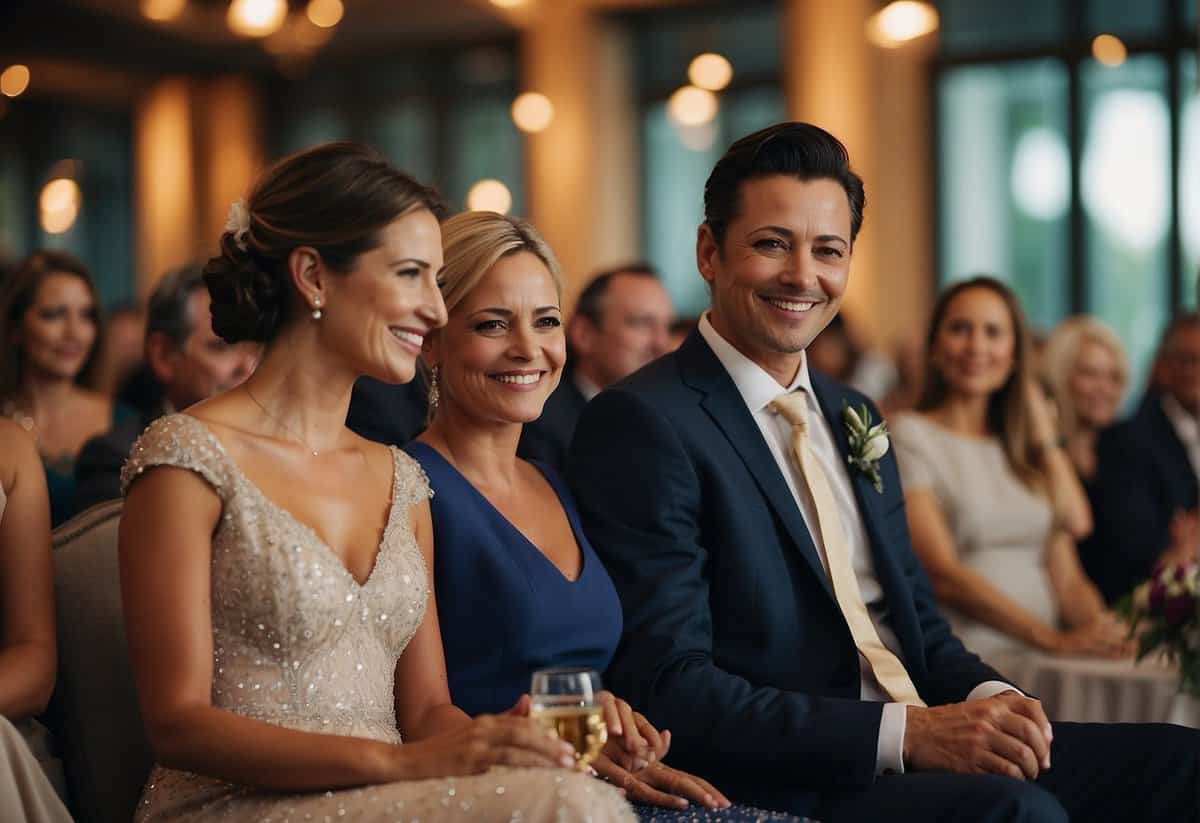
When planning wedding reception seating, certain unique situations require extra attention to ensure that everyone feels included and comfortable. Here’s a look at how to approach multicultural and same-sex weddings, as well as seating options for guests with kids.
Addressing Multicultural and Same-Sex Weddings
For a multicultural wedding, like a Jewish wedding, respecting traditions is key. You may choose to have separate tables for each culture to honor distinct customs, or mix guests to foster unity. Same-sex couples may also face unique considerations. Whether you’re part of a same-sex couple or have close relatives or friends who are, consider seating by relationship rather than traditional gender roles. Place ushers and groomsmen from both sides together, and blend bridal party members at adjacent tables or at one, inclusive bridal party table.
Managing Seating for Guests with Kids
Guests with kids, especially young kids, need thoughtful seating. For example, placing ring bearers or children of the bridal party close to their parents is considerate. You could set up a kids’ table if there are enough children, but keep it within sight of their parents’ tables for safety and comfort. Alternatively, seat families at the same table to keep them together. This approach often makes it easier for parents to tend to their children and allows spouses to assist each other with childcare as needed, without disrupting the flow of the event.
Navigating Post-Ceremony Celebrations
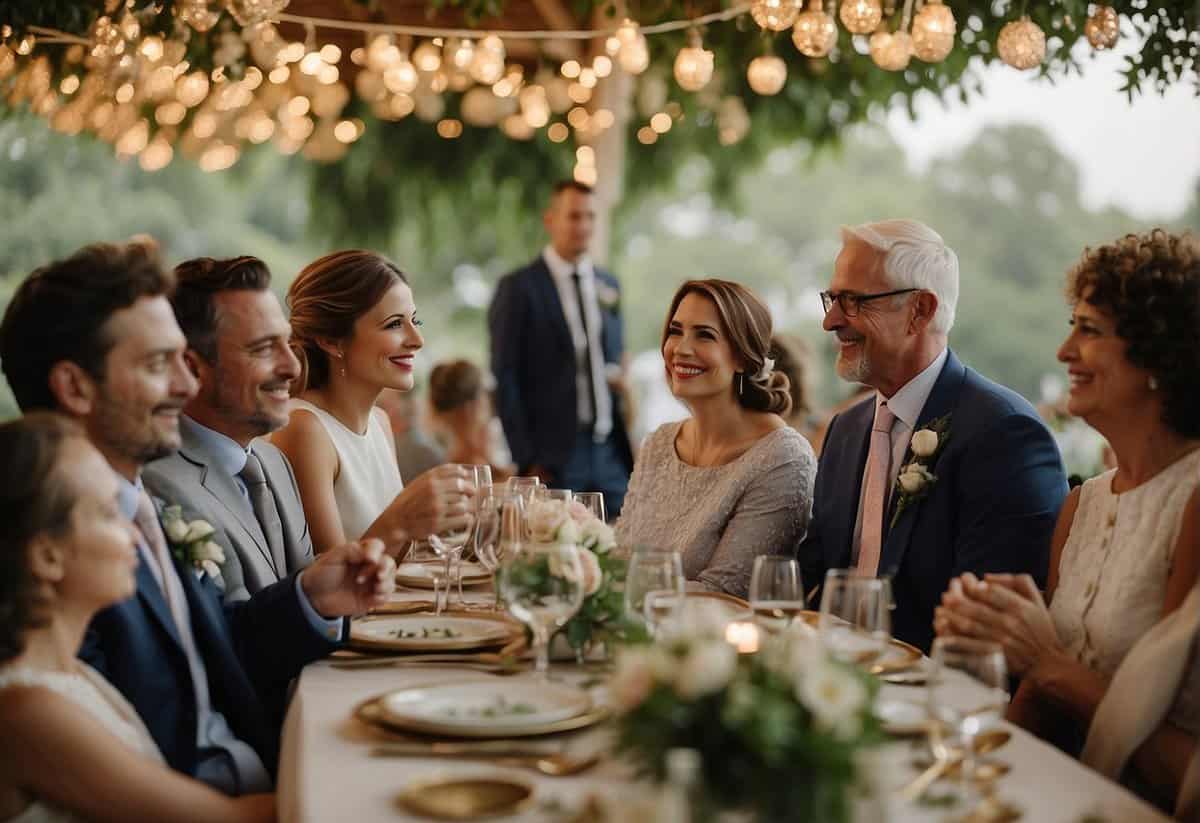
After the wedding ceremony concludes, it’s time to celebrate the union with friends and family. Your goal is to create an inviting atmosphere that encourages both conversation and celebration. Keep in mind that the arrangement of the dance floor and seating can greatly influence the flow and feel of the evening.
Planning the Dance Floor and Mingling Areas
The dance floor is often the heart of post-ceremony celebrations. You want to ensure it’s adequately sized for your number of guests so everyone feels invited to join in. Positioning it centrally can help draw your guests in, encouraging them to dance and mingle. It is also essential to have mingling areas with a few standing tables, especially for those who may need a break from dancing. By doing so, you’ll encourage getting along amongst the diverse group of close family members and guests of the bride and groom.
Seating for the Reception and Toasts
When planning the reception table layout, consider the view of the bride and groom during toasts and other key moments. Traditionally, the parents of the couple often sit at a table adjacent to the main reception table, but this can vary. To foster a unified family atmosphere, consider whether your parents and your partner’s parents will enjoy sitting together or if they’d prefer to be with their own friends and relatives.
Reserve seats at the front of the ceremony for your grandparents and other VIPs to honor their importance. The maid of honor and other bridal party members typically have a reserved seat at or near the main table. By thinking through the floor plan carefully, your post-ceremony celebrations can be comfortable and joyful for every attendee.
Frequently Asked Questions
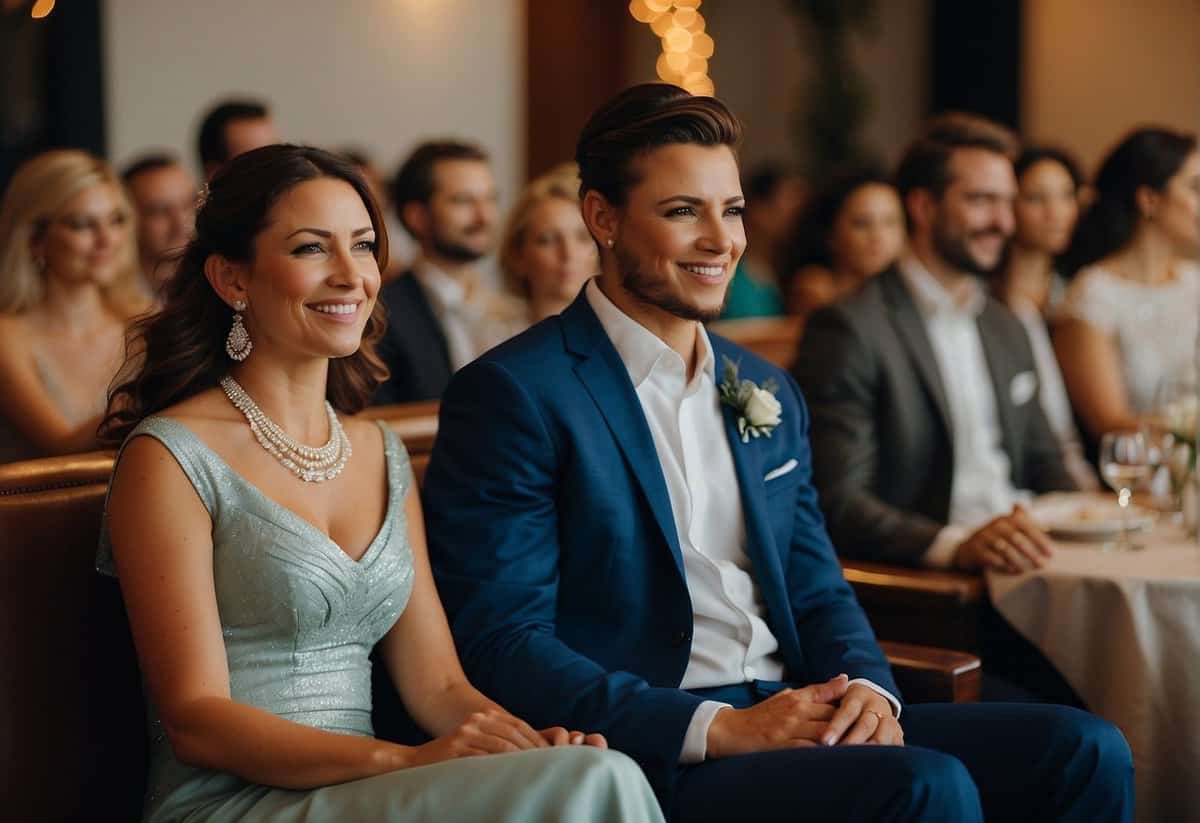
Navigating the nuances of wedding etiquette can be a bit tricky, especially when it comes to seating arrangements. This section answers some common questions to help you plan where family members, particularly parents, should be seated during the wedding festivities.
How is seating arranged for parents at a wedding reception?
At the reception, parents of the couple are often seated at tables close to the bride and groom, with the bride’s parents on her side and the groom’s on his. They may choose to fill their table with friends if they prefer.
What is the appropriate way to seat divorced parents at a wedding ceremony?
For divorced parents, each parent can be given their own row or they can share the first row, depending on comfort levels and relationships. Amicable situations may allow for shared seating, while it’s best to provide separate spaces in more contentious circumstances.
What are the traditional seating arrangements for family members at a wedding reception?
Traditionally, family seating at a wedding reception includes tables near the newlyweds, with immediate family like parents and siblings often displayed at tables that flank the couple’s main table.
In what order are parents typically seated at a wedding ceremony?
During the ceremony, parents are seated with the bride’s parents in the first pew or row on the left, and the groom’s parents on the right. In same-sex marriages, couples may assign sides as preferred.
What is the seating etiquette for a parent’s significant other at a wedding?
If a parent has a significant other who is not a step-parent to the bride or groom, that person is typically seated next to them, either at the same table with other family members or at a separate table close by, depending on space and relationships.
How do you determine the seating plan for the bride and groom’s families at a wedding?
To create a seating plan that honors both families, consider relationships, cultural traditions, and the comfort of all guests. It’s common to have each family seated at tables near the couple to showcase their importance.
